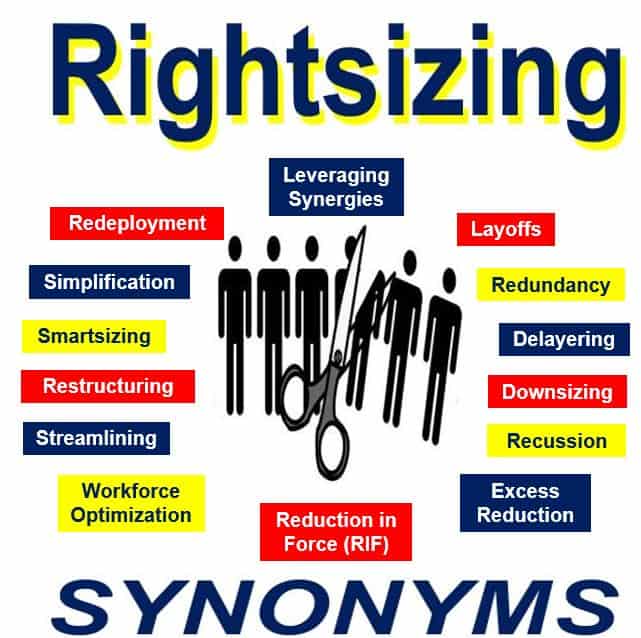Rightsizing is the process of a company restructuring or reorganizing itself by reducing its workforce, cost-cutting, or rearranging its upper management. The aim is to streamline the business so that it can make a profit more effectively. Technically, the term means adapting the company to market conditions, which in theory could also mean increasing the workforce.
While rightsizing may involve reducing staff, it also encompasses optimizing business processes and enhancing efficiency across various departments.
In IT (information technology), the term refers to the process of reorganizing or restructuring an organization’s network, IT infrastructure, data center, storage, hardware or other components in an attempt to get the maximum value from those services.
In today’s fast-changing business environment, the ability to adapt and respond rapidly is crucial for survival. Cutting staff numbers has become much more common in the world of business since the 1980s.

It is a common measure that companies take during times of poor financial performance or market volatility.
Rightsizing vs. downsizing
The term downsizing has virtually the same meaning. Business leaders often use ‘rightsizing’ because it sounds less alarming, as in: “After three consecutive quarters, the Board decided that rightsizing was necessary.”
The more cynical among us might say that the term is a euphemism for mass layoffs. Rather than telling people that mass redundancies are going to take place, saying that it is now time for rightsizing sounds less drastic.
Technically, downsizing means having to reduce the workforce, while rightsizing is just adjusting the workforce to get it to the right size – this could mean increasing the number of workers (rare).
When you rightsize, you typically do so on an ongoing basis, while downsizing is a specific action. Any business that calls layoffs ‘rightsizing’, but the move is a short-term one, is more likely downsizing.
Challenges when rightsizing
-
Morale
Redundancy can undermine morale among the employees who are not dismissed, as well as leading to job insecurity – this causes high attrition (you lose them).
If reducing the workforce is not well managed, those who are made redundant may complain bitterly online in forums and social network websites. Newspapers and other media soon pick up on this, and the bad news spreads rapidly. Applicants who are offered jobs in the company may be less keen about joining.
-
Brand image
Rightsizing can have a negative effect on a company’s brand image, which makes recruitment and the selection of new resources more difficult. In fact, even sales may be harmed.
Moreover, a company’s long-term innovation and growth potential may be stifled, as rightsizing could lead to a reduction in the diversity of skills and experience among the remaining workforce.
President and Chairman of the Australian Human Resources Institute (AHRI), Peter Wilson, said US studies showed that employers who reduced their workforce by 10% often ended up losing another 25% of their workers voluntarily over the next three years.
This made it extremely difficult to cope effectively when business started to pick up again.
-
Outplacement services
Companies that are making workers redundant and offer a comprehensive outplacement service free of charge tend to have fewer problems.
Rightsizing is one of many euphemisms for making people redundant – the following terms are sometimes used for the same reason:
- delayering
- downsizing
- excess reduction
- leveraging synergies
- redeployment
- RIF (reduction in force, especially in the civil service)
- simplification
- smartsizing
- workforce optimization
The suffix ‘-izing’
The terms ‘downsizing’ and ‘rightsizing’ both have the same suffix ‘-sizing.’ Here are some more business and non-business terms with the same suffix:
-
Capsizing
This term is generally used outside of a business context and refers to a ship or boat overturning in the water.
For Example: “The small vessel risked ‘capsizing’ in the turbulent waters during the storm.”
- Upsizing
Increasing in size, often referring to the expansion of a company’s workforce or operations.
For Example: “With the increase in demand, the factory is ‘upsizing’ its production capacity.”
-
Resizing
Adjusting the size of something, which can refer to various contexts, from business operations to digital images.
For Example: “The graphic designer spent the afternoon ‘resizing’ images for the new website.”
-
Supersizing
Greatly increasing the size or amount of something, often used in the context of food servings.
For Example: “Fast food restaurants often offer ‘supersizing’ options for an extra charge.”
2 Videos
These two interesting video presentations, from our sister YouTube channel – Marketing Business Network, explain what ‘Rightsizing’ and ‘Downsizing’ are using simple, straightforward, and easy-to-understand language and examples.
-
What is Rightsizing?
-
What is Downsizing?
